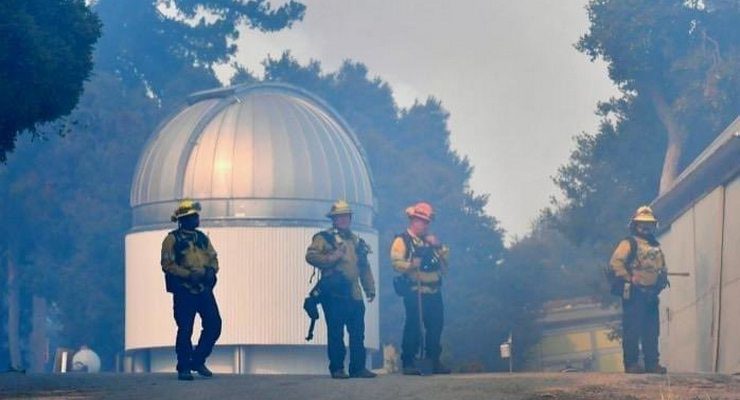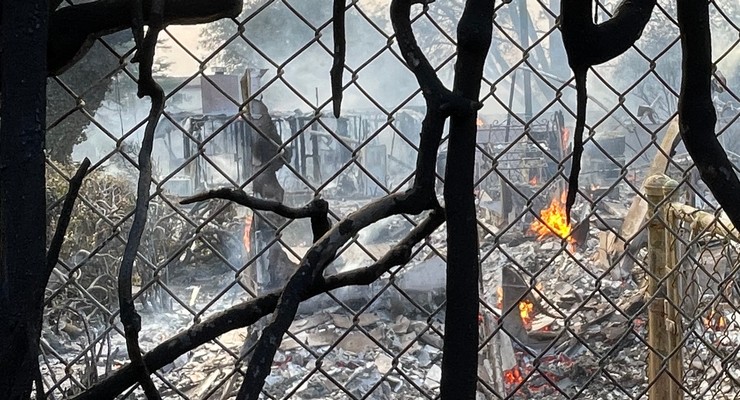
The Bobcat Fire in the Angeles National Forest has prompted new evacuation orders in the foothills of the Antelope Valley as homes were destroyed and firefighters braced for an overnight fight made tougher by the possibility of wind gusts of up to 30 miles an hour.
The Los Angeles County Sheriff’s Department said Saturday afternoon that all residents were ordered to leave in an “evacuation box” south of 138th Street East, north of Big Pine Highway and Highway 2, west of 263rd East and east of Largo Vista Road. Saturday evening, the unified fire command issued new evacuation orders for people living northwest of Mt. Emma, southeast of Highway 122 and west of Cheeseboro Road.
The fire has scorched 91,017 acres and remains at 15% containment Saturday, with full containment estimated by Oct. 30.
Structures have been damaged and losses were expected, according to Vince Pena, unified incident commander with the Los Angeles County Fire Department. The number of homes affected was not available.
Earlier broadcast reports from the scene showed structures that appeared to be homes burning in the Juniper Hills area, but the U.S. Forest Service could not confirm that.
The Los Angeles Fire Department is now sending two strike teams under the mutual aid agreement to help fight the Bobcat Fire, L.A. Mayor Eric Garcetti said.
The agency said Saturday morning that crews would be focusing “on securing the fire’s perimeter in the north in an effort to stop any additional spread, especially to the communities in the northeast and northwest. Expect fire growth towards Wrightwood on north and west around Chilao.”
At around 2:30 p.m. Saturday, the fire was making a hard push west toward Cheseboro Road near the Little Rock Reservoir, and air support was requested to slow it down.
On the fire’s southern end, evacuation warnings were lifted as of 4 p.m. for the communities of Sierra Madre, Arcadia, Monrovia, Bradbury and Duarte in the San Gabriel Valley, while the warnings for Altadena and Pasadena remained in effect.
“No additional strategic aerial firing will be occurring today near the San Gabriel Reservoir,” the ANF tweeted Saturday. “Large pockets of unburned islands of fuel remain within the perimeter that will be actively burning and producing smoke throughout the day.”
A total of 1,663 personnel are currently assigned to the fire.
It exploded in size Friday, growing by more than 17,000 acres and making a “hard push to the west and north” as wind gusts reached 44 mph, the Forest Service said.
“Mt. Wilson is still safe and we will continue to focus on the north end of the fire,” officials said after daybreak Friday. Fire retardant was placed around Mount Wilson.
Crews have been working for days to protect the Mount Wilson Observatory and nearby broadcast towers, valued at more than $1 billion, from approaching flames.
Observatory personnel were evacuated. Mount Wilson is not only one of the crown jewels of astronomy but also home to infrastructure that transmits cellphone signals and television and radio broadcasts for the greater Los Angeles Area.
A closure order has been issued for all National Forests in Southern California.
The South Coast Air Quality Management District extended its smoke advisory through Sunday, with officials warning that “smoke may impact different parts of the region at different times.”
Residents were advised to limit their outdoor exposure as much as possible, and keep doors and windows closed.
The Bobcat Fire erupted on Sept. 6 near the Cogswell Dam and West Fork Day Use area northeast of Mount Wilson and within the Angeles National Forest. The cause remains under investigation.














 0 comments
0 comments



